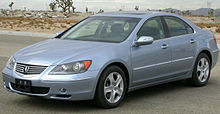Acura
In its first few years of existence, Acura was among the best-selling luxury marques in the US, outselling established brands such as BMW and Mercedes-Benz.
[7][8] In the late 1980s, the success of the company's first flagship vehicle, the Legend, inspired fellow Japanese automakers Toyota and Nissan to launch their own luxury brands, Lexus and Infiniti, respectively.
The 1993 Legend coupé featured Acura's first use of a six-speed manual transmission mated to a Type II engine.
In the late 1990s, Acura produced a Type R version of its compact Integra, which featured a reduced curb weight, a stiffer and lower suspension, and a high-output VTEC engine.
Following a decade of research, Honda opened 60 new dealerships in North America by 1986, to support its Acura automobile division.
The Legend was the result of Project XX, a joint venture Honda entered into with the UK's Austin Rover Group.
[13] The success of these models, particularly the Legend, led to competing Japanese luxury brand ventures (Toyota's Lexus that began development in 1983 as the F1 project, and Nissan's Infiniti who began development in 1985 by revising their Japan-only flagship Nissan President; in the late 1990s Mazda planned but never launched its own Amati luxury division).
[7] In 1990, five years after the debut of the Legend and Integra, Acura introduced the NSX, a midship V6 powered, rear-wheel-drive sports car.
The NSX, an acronym for "New Sports eXperimental", was billed as the first Japanese car capable of competing with Ferrari and Porsche.
Additionally, during this time Acura switched to an alphanumeric nomenclature formula, dropping the Legend, Vigor and Integra titles, following the lead of the NSX sportscar.
A year later, the Integra sedan was withdrawn from the Canadian market, replaced by the market-exclusive Acura 1.6 EL, a rebadged Honda Civic/Domani.
Parent company Honda's reputation with this demographic as a maker of "easy-to-tune" and "rev-happy" engines rubbed off onto Acura, and the Integra became a popular tuner car.
Another refreshed Acura introduced in the early 2000s was the MDX, a popular three-row crossover SUV based on the Honda Odyssey minivan.
However in the midsize luxury segment, RL sales lagged far behind not only the best-selling German offerings but also Japanese contemporaries like the Lexus GS and Infiniti M. Honda Japan had set the RL's initial price high, close to those with V8 engines, disappointing potential customers who perceived Acura as not being on par with its German rivals in brand equity and expected more value from the Japanese marque.
[21] In 2006 Acura introduced a compact crossover SUV which was based on its own unique unibody chassis called the RDX with models becoming available to U.S. consumers in August 2006.
Acura planned on redesigning the RL by 2011 as well as announced the creation of a brand new luxury crossover vehicle called the ZDX, previewed by the concept of the same name.
The ZDX was designed by Michelle Christensen and based on the Acura MDX using that vehicles 3.7 litre V6 engine (300 bhp) and SH-AWD system.
The production model of the ZDX made its debut in the Orange County Auto Show in Southern California on 15 October 2009.
Mechanically the engine remained unchanged but the transmission was updated from the previous 5-speeds to 6-speeds including steering column mounted shift override paddles.
In December 2013, at the Los Angeles Auto Show, Acura unveiled a Sport Hybrid SH-AWD version of the flagship RLX sedan.
Acura technology firsts on the 2014 RLX Sport Hybrid SH-AWD also include an electronic gear selector that replaces the conventional, center console-mounted shift lever with an efficiently packaged push-button array allowing the driver to easily select the desired mode—Park, Drive and Reverse, as well as Sport and Normal driving modes.
Added is the signature Acura Jewel Eye LED headlights, LED taillights, updated wheels, suspension modifications, bumper redesign, and new packages such as AcuraWatch Package (includes adaptive cruise control, collision mitigation, lane keeping assist system, road departure mitigation, and forward collision warning) and A-Spec (sportier appearance).
A new Advance Package is being offered with the inclusion of, parking sensors (front and rear), rain-sensing windshield wipers, auto-dimming side mirrors, remote start, ventilated seats, and foglights.
[23] Almost since its inception, Acura has been involved in American motorsports, specifically in Sports Car Club of America (SCCA) and IMSA GT Championship series.
Realtime took the touring championship with the Integra again in 1998, and came within a few points of winning it again in 1999 only to lose it in the final race, then coming back to retake the title in 2000.
Although the NSX squad suffered mechanical woes and were unable to take the title, the Integras of the touring class once again took the teams championship.
The logo that was originally authorized without approval by Soichiro Honda did not contain the small horizontal bar joining the two vertical pillars—thus, it did not form the letter "H".
Soichiro Honda ordered the 5,000 badges already produced to be destroyed, including prying off the emblems applied to 309 cars already (US-spec Integra, Legend, and NSX models).
Technology and Advance models typically come with the latest hi-tech features such as keyless start and a blind spot information system.
[29] Acura began an association with Marvel Entertainment in 2010, upon release of the film Iron Man 2, which featured a ZDX after the ending credits.

















